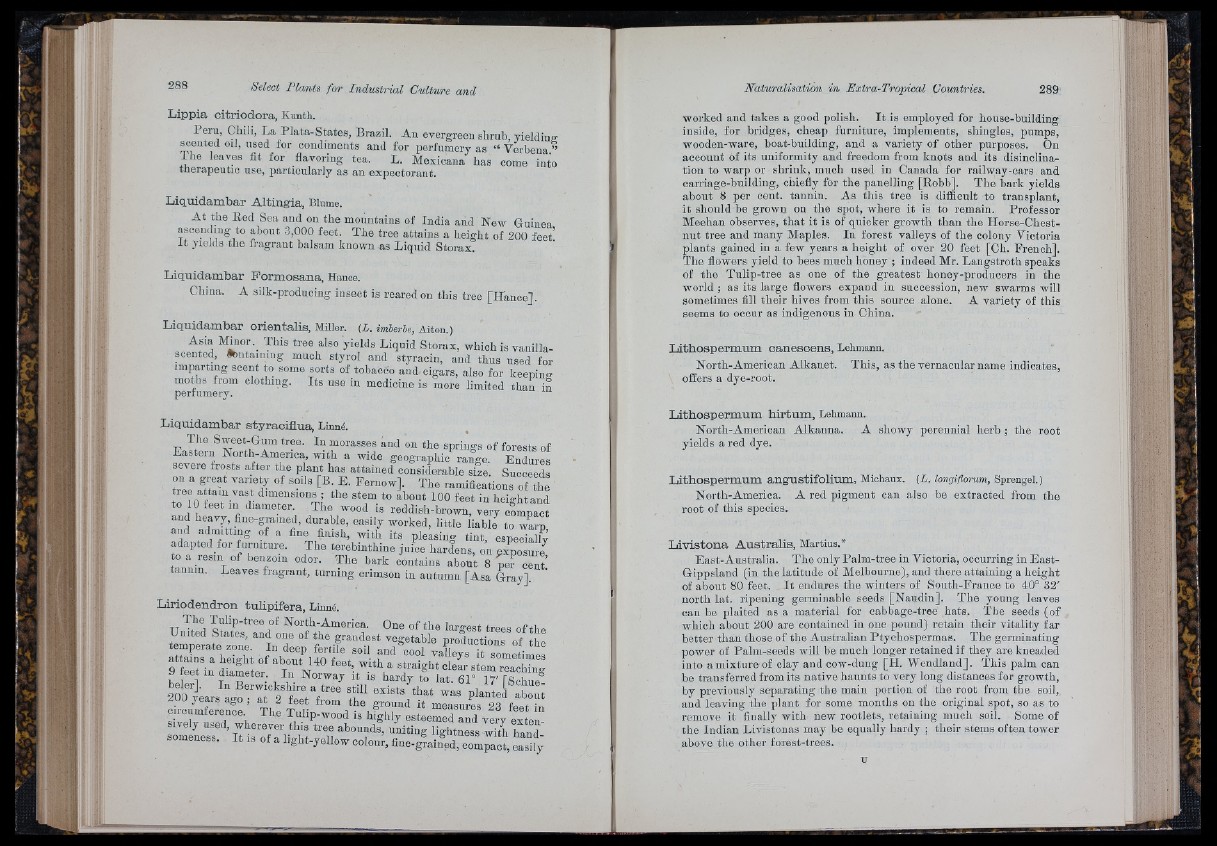
Lippia citriodora, Kunth.
Peru, Chili, La Plata-States, Brazil. An evergreen shrub, yieldiuo-
scented oil, nsed for condiments and for perfumery as “ Verbena”
The leaves fit for flavoring tea. L. Mexicana has come into
therapeutic use, particularly as an expectorant.
Liquidambar Altingia, Blume.
A t the Red Sea and on the mountains of India and New Guinea
ascending to about 3,000 feet. The tree attains a height of 200 feet’
I t yields the fragrant balsam known as Liquid Storax.
Liquidambar Pormosana, Hauce.
China. A silk-producing insect is reared on this tree [Hance].
Liquidambar orientalis, Miller. (L. imberbe, Aiton.)
Asia Miiior.^ This tree also yields Liquid Storax, which is vanilla-
scented, fciitainiug much styrol and styracin, aud thus nsed for
imparting scent to some sorts of tobacco and cigars, also for keeping
moths from clothing. Its use in medicine is more limited than in
perfumery.
Liquidambar styraciñua, Linné.
The Sweet-Giim tree. In morasses and on the springs of forests of
Eastern North-Amerioa, with a wide geographic range. Endures
seveie frosts after the plant has attained considerable size Succeeds
The ramifications of the
tree attain vast dimensions ; the stem to about 100 feet in height and
to 10 feet in diameter. The wood is reddish-brown, very cmnoaet
and heavy fine-grained, durable, easily worked, little liable to wLp
and admitting of a fine finish, with its pleasing tint especiallL
adapted for furniture. The terebiuthiue juice hardens, ou exposure
to a resin of benzoin odor. The bark contains about 8 p 7 / 7 t ’
tanum. Leaves fragrant, turning crimson iu autumn [Asa Gray].
Liriodendron tulipifera, Linné.
TT 0* North-America. One of the largest trees ofthe
United States, and one of the grandest vegetable productions of the
temperate zone. In deep fertile soil and'cool v aL y s it somelime!
attains a height of about 140 feet, with a straight clear s tem r T a c ^ Z
h e i r i f , 7 . Norway it is hardy to lat. 61° 17' [Schue'-
be er]. In Berwickshire a tree still exists that was planted U b 7 t
200 years ag o ; a t 2 feet from the ground it measures 23 feet /n
cn-cnmference The Tulip-wood is highly e s te em e dT d v ï y ex en
aaommeinieLssr. ’ uI t Sis oXf a rli ghUt- yellow colour, fine-grained, compact, ehaasnidly!
worked and takes a good polish. I t is employed for house-building
inside, for bridges, cheap furniture, implements, shingles, pumps,
wooden-ware, boat-building, and a variety of other purposes. On
account of its uniformity and freedom from knots and its disinclination
to warp or shrink, much used in Canada for railway-cars and
carriage-building, chiefly for the panelling [Robb]. The bark yields
about 8 per cent, tannin. As this tree is difficult to transplant,
it should be grown on the spot, where it is to remain. Professor
Meehan observes, th a t it is of quicker growth than the Horse-Chestnut
tree and many Maples. In forest valleys of the colony Victoria
plants gained in a few years a height of over 20 feet [Ch. French],
The flowers yield to bees much honey ; indeed Mr. Langstroth speaks
of the Tulip-tree as one of the greatest honey-produoers in the
world ; as its large flowers expand in succession, new swarms will
sometimes fill their hives from this source alone. A variety of this
seems to occur as indigenous in China.
L i t h o s p e rm u m c a n e s c e n s , Lehmann.
North-American Alkanet. This, as the vernacular name indicates,
offers a dye-root.
L i t h o s p e rm u m h i r tu m , Lehmann.
North-American Alkanna. A showy perennial herb ; the root
yields a red dye.
L i t h o s p e rm u m a n g u s t if o l iu m , Michaux. (L. longiflorum, Sprengel.)
North-America. A red pigment can also be extracted from the
root of this species.
L iv i s t o n a A u s t r a l i s , Martius.*
East-Anstralia. The only Palm-tree in Victoria, occurring in East-
Gippsland (in the latitude of Melbourne), and there attaining a height
of about 80 feet. I t endures the winters of South-France to 40° 32'
north lat. ripening germinable seeds [Naudin]. The young leaves
can be plaited as a material for eabbage-tree hats. 'The seeds (of
which about 200 are contained in one pound) retain their vitality far
better than those of the Australian Ptychosperrnas. 'The germinating
power of Palm-seeds will be much longer retained if they are kneaded
into a mixture of clay and cow-dung [H. Wendland]. 'Phis palm can
be transferred from its native haunts to very long distances for growth,
by previously separating the main portion of the root from the soil,
and leaving the plant for some months on the original spot, so as to
remove it finally with new rootlets, retaining much soi . Some of
the Indian Livistonas may be equally hardy ; their stems often tower
above the other forest-trees.